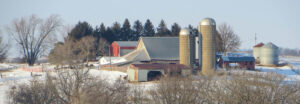Purpose
As you’ve learned, one of the main historical thinking tools that historians use to analyze and produce accounts of the past is comparison. In this activity, you’ll learn how to evaluate for continuity and change over time (which we’ll refer to as CCOT throughout the course), so that you have a method for comparing how the same location, idea, or historical process either stayed the same or changed during a set time in history. This process will help you make claims in response to questions about how things have stayed the same or changed in history.
Practices
Comparison, causation
Continuity and change analysis involves comparison, but it’s different from the kind of historical comparison that you’ve been introduced to in this course until now. Typically, historical comparison involves examining the similarities and differences between two things, while CCOT looks at how things stayed the same or changed over time. Comparison is often a component of a CCOT analysis. Additionally, part of understanding how and when a change occurred is related to understanding the causes and consequences of those changes.
Process
What are continuities? What are changes? How do these relate to history? We refer to continuities as the things that have stayed the same over time in history. And changes—which are often easier to identify—are the things that did not stay the same. Something historians often do is called a “continuity and change over time analysis” (CCOT for short). We do this by looking at how certain things changed or stayed the same over time. One of the reasons why historians find CCOT analysis useful is that recognizing what has stayed the same helps us decide which changes throughout history were the most significant. This, in turn, allows historians to see how those changes may have led to major transformations in how people lived and continue to live today.
Instead of looking at an event or something that happened at a defined moment or time period, we are now trying to understand how farms, one of the mainstays of societies since the development of agriculture, have evolved. We are going to look at farms in the state of Iowa from the 1700s, 1800s, 1900s, and today, to determine what about farms has changed, and what about farms has stayed the same over time. HINT: This sentence will help you with “Periodization” portion in the worksheet below.
You will now do an exercise now that uses the CCOT Worksheet (PDF)| CCOT Worksheet (Word)
Part 1: Glance at the pictures of the four farms below (you can click on them to enlarge). Based on just the images, take notes on what is the same and what is different about the four farms (You will use the CCOT Worksheet (PDF)| CCOT Worksheet (Word) in Part 2). Remember that the things that are the same are continuities. And, the things that are different are, you guessed it, changes!
Part 2: Now, let’s download more information about these farms (Four Farms with Descriptions) and dive deeper (Pages 1 and 2 of the CCOT Worksheet (PDF)| CCOT Worksheet (Word) )
1. List all of the continuities you can find—in other words, write down the things that have stayed the same.
2. List all the changes you can find.
3. Label the continuities and changes according to each frame.
4. Decide which changes and continuities were the most significant.
5. Decide if the most significant changes and continuities were positive or negative.
Part 3: Now that you’ve come up with your most significant continuities and changes, you’re going to plot these on a graph (page 3 of the CCOT Worksheet (PDF)| CCOT Worksheet (Word)). The graph tells more of a story than a simple list of continuities and changes, and this should help you (in the future) write responses to CCOT prompts and questions.
- Choose your most significant changes and your most significant continuities and write them down.
Part 4: Upload your completed CCOT Intro Worksheet onto Blackboard. (this can be typed or handwritten)
- Answer questions via Blackboard – Section 002
- Answer questions via Blackboard – Section 008
- Answer questions via Blackboard – Section 025




